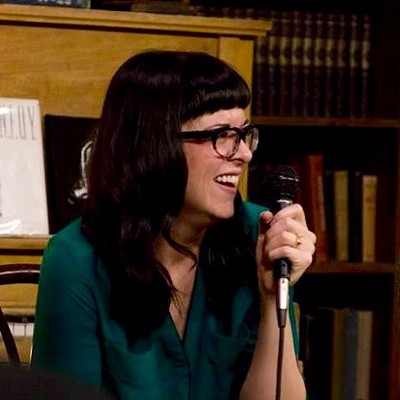In 2005 she started the Hyperbolic Crochet Coral Reef project with her sister, Christine Wertheim. This ever-evolving textile model of the fragile and endangered ocean landscape exists at what Wertheim calls "the intersection of art, science, environmental consciousness, community art practice and feminism." Speaking in advance of her lecture on "DIY Science" at the final installment of this season's Feminism & Co. at the Museum of Contemporary Art Denver , Wertheim gave Westword some insight into her massive undertaking, and what she hopes comes from the community-driven feminist art and science effort.
Westword: Can you talk a little about who you are and what you do?
By profession I'm a science writer -- I write books and articles for magazines and newspapers about science and technology, and I founded an organization a few years ago called the Institute for Figuring. It does a lot of exhibitions and public programming to introduce people to science, mathematics and engineering in new and interesting ways. The crochet reef project began six years ago, and my sister Christine (Wertheim, professor in the Department of Critical Studies at CalArts) and I started it because we wanted to do several things at once: We wanted to have a participatory art project that would engage lots of different people, particularly women.
What is the coral reef project about, exactly?
We wanted to do something that would also draw attention to the plight of coral reefs around the world, which are being devastated by global warming and ocean acidification. The reason that we're crocheting a coral reef is because it turns out that all of those sort of frilly, crenulated forms that you see in coral reefs are actually the natural form of a geometry called hyperbolic geometry. It turns out that the best way to make models of those forms is with crochet.
It's pretty hard to make models of hyperbolic space, although nature has been doing it for hundreds of millions of years. A mathematician named Dr. Daina Taimina discovered that you could, in fact, make models of this geometry with crochet. It was a discovery she made in 1997, and my sister and I started playing around with what you could do with these crochet models. After a while we decided that we didn't want to make mathematically perfect ones anymore. Instead, my sister started deviating and making ones that were a little bit wonky and they started to immediately looking organic and natural -- they started looking like a coral reef. We had little clusters of them sitting on my coffee table, and my sister said, "What if we could crochet a coral reef?"
We thought that would be a lovely way to get a lot of women involved, and we could teach them about mathematics and geometry, while they were doing their crochet. It would also be a way to do a beautiful collective art project and bring together lots of different people and build something that was a beautiful invocation of a coral reef. It would also be a way to bring attention to fact that coral reefs are being devastated by global warming.
On Page 2: Watch Wertheim's TED talk and read more of this interview.
What, to you, is the feminist aspect of this project?
Basically, we think of it as a project that exists at the intersection of art, science, environmental consciousness, community art practice and feminism. Christine and I regard ourselves as feminists with every fiber of our being. Our mother was a leading feminist in Australia in the 1970s. We were brought up with feminist presuppositions and we believe that the collective work that women do (and have done) throughout history and even today is often ignored and undervalued.
This project has been a way to engage thousands and thousands of women. We've now had at least 5,000 women who have actively made models that have been exhibited in one of our exhibitions. Collectively, these women have built something that is really extraordinary using a traditionally feminine handicraft. Part of what's important for us about this is it's a way of giving voice and recognition to what is often been regarded as a very undervalued feminine labor.
So, you're teaching about something assumed to be complex like mathematics, while utilizing an art form often dismissed as trivial busywork, like crochet?One of the things that I think has struck so many people about the project is that it combines a traditional feminine handicraft with really important mathematics. And it should be said that the mathematics of hyperbolic space, when it was discovered in the nineteenth century, actually, started a whole new branch of geometry called Non-Euclidean Geometry.
Non-Euclidean Geometry is the geometry and mathematics that underly the theory of relativity, which will therefore be used to tell us about the shape of the universe as a whole. One of the things we think is important about this project is that it tends to subvert our ideas about the separation of disciplines. So often in our society, you have the mathematicians over there doing their mathematics, and the women over there doing their handicraft and the environmentalists over in another corner doing there thing, and we tend to think if these as separate disciplines. But in fact, this project brings them all together and suggests that mathematics, environmentalism, handicraft and community art are not necessarily separate categories of human activity.











